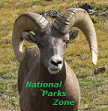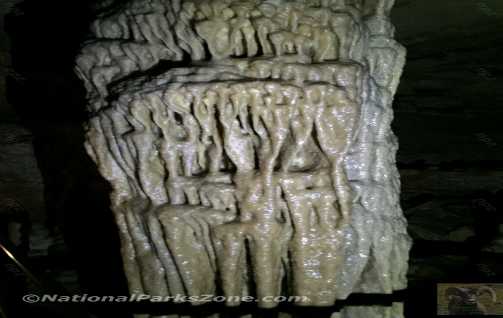Copyright © 2014-
All Rights Reserved

Updated 02/11/23 7:04 PM
Other Resources
Mammoth Cave National Park on the National Parks Service website -
Mammoth Cave National Park -
Mammoth Cave National Park -
Mammoth Cave National Park -
Mammoth Cave National Park -
Mammoth Cave National Park -
Mammoth Cave National Park -
Mammoth Cave National Park -
Mammoth Cave National Park -
Mammoth Cave National Park -
Mammoth Cave National Park -
Mammoth Cave National Park -
Mammoth Cave National Park
Kentucky's Mammoth Cave National Park encompasses portions of the Mammoth Cave-
Kentucky
2016
About The Park
The word mammoth in Mammoth Cave National Park has nothing to do with the extinct elephant-
Mammoth Cave is the richest habitat for cave wildlife in the world. Over 130 different species make the cave home. These include eyeless fish, cave spiders, cave salamanders, albino cave shrimp, white crayfish and rare beetles.
These types of creatures are called troglobites and have developed adaptations for surviving in darkness. These include decreased or loss of eyesight, absence of pigmentation, decreased energy consumption, slow metabolism and better food usage efficiency due to the scarcity of it and the difficulty of hunting in total darkness.
Above the caves are 53,000 acres of forest bisected by the Green River. In the northwest corner of the park a tributary of the Green River, the Nolin River, enters the park and connects with the Green River. Both of these rivers are navigable and available for canoeing, kayaking and paddling. The park has 84 miles of trails for hiking, horseback riding and biking through lush forests.
Legend has it that the cave was discovered by European settlers around 1797. Starting around 1838 it became a tourist attraction and various owners profited by giving tours to interested visitors. It eventually became an international sensation and was visited by many famous, and not so famous, people some of whom burned their names and dates onto the cave ceiling that can be seen to this day.
One of Mammoth Cave’s most accomplished explorers was Stephen Bishop who was an enslaved African American and served as one of Mammoth Cave’s first tour guides. Only seventeen when he was brought to the cave, he was intelligent, charismatic and an adventurous young man. He created the first map of the cave and greatly expanded the understanding of it. It was he who found and named many of the formations and also led visitors on tours. He gained his freedom in 1856 but sadly died the next year at age 37. The cause of his death is unknown. He is buried in the “Old Guide’s Cemetery” which is located on the top of a ridge south of the cave entrance.
Of the 400 miles of cave passageways about 10 miles are available for tours. The year-
On one of the cave tours the guide told an interesting story regarding tour operators conducting tours, in the 1800’s, of caves under land owned by other people. He said the legal battle was fought all the way up to the Supreme Court which established that, if you own the land on the surface, you own everything below it all the way down to the center of the earth. He pointed to a line marked on the cave wall as the old dividing line for land owned by two surface property owners as a result of that decision. I’ve tried hard to confirm this story without any success. The Park Service’s own document, which is no longer available, on A Short Legal History of Mammoth Cave made no mention of it.
My own feeling about Mammoth Cave National Park is that, while it is certainly worthy of being a national park and worth a visit, it is one of my least favorite national parks. The caves were dark and slippery and the formations, at least on the three tours that I took, were few and far between. Compared to Carlsbad Caverns National Park, Wind Cave National Park and even Lehman Cave at Great Basin National Park, Mammoth Cave fell short in terms of the amount of the formations the overall beauty of the cave.
The Caves
The main reason for visiting Mammoth Cave National Park is for the caves. It is truly an extensive system spanning a large area and more caves are discovered regularly. The map in the visitor’s center showing the extent of what is currently known shows a system of many levels that extends beyond the boundaries of the park.
Cave Tours
There are a number of different tours of varying lengths available from the National Park Service.
The tours are reasonably priced and, if you have a national parks pass or senior pass, they are half-
Domes and Dripstones and the Great Onyx
The Domes and Dripstones and the Great Onyx tours had the most impressive stalactite and stalagmite formations.
Gothic Avenue
The Gothic Avenue tour was darker and drearier. It had more the feeling of a dark, dank cave with little in the way of impressive formations to see. Here is where you can see the names of past visitors on the cave ceilings.
These tours were roughly about two hours each. There are tours that take up to about five hours. Most of the popular tours are in foot-
Wildlife
Mammals include coyote, raccoons, red fox, bobcats, muskrat, flying squirrels, skunks, ground hogs, mink, weasels, rabbits and, of course, a variety of bat species.
There are about 20 species of snakes in the park.
Among the birds are herons, Canada geese, swans and bald eagles.
Lodging
Lodge at Mammoth Cave
The Lodge at Mammoth Cave is located in the park and is the place you want to stay. It’s a motel style structure with modern rooms that have the typical amenities, that one expects these days, at a very reasonable price. It is set on the edge of the forest with easy access to some hiking trails.
Hiking
The park is divided into the front country, which is the area south of the Green River and is where the visitor center and lodge are, and the back country which is the area north of the Green River. Of the park’s 84 miles of trails 65 miles are in the back country. I only hiked the trails in the lodge area which are all on the short side.
River Styx Spring Trail and Heritage Trail
The River Styx Spring Trail was a easy nice walk down to the Green River. When combined with the Heritage Trail it makes for a nice loop hike.
Other Points of Interest
There’s a quaint little ferry, the Green River Ferry, which is about a 2-
Within 20 to 30 miles you can find the following attractions:
Dinosaur World, Kentucky Down Under Adventure Zoo, Kentucky Action Park and the Mammoth Cave Wildlife Museum.
Mammoth Cave National Park Photo Gallery

Other National Parks Within a Day’s Drive
Great Smoky Mountains National Park America’s most visited National Park lies in Tennessee and North Carolina is 286 miles to the northwest and about a 5 hour drive.
Gateway Arch National Park This monumental arch is 333 miles to the northwest and about a 5.5 hour drive.
New River Gorge National Park Where you can see a steep gorge and a graceful steel arch bridge that rises 876 feet above the river. It is 380 miles to the east and about a six hour drive.
Cuyahoga Valley National Park Located outside of Cleveland, Ohio and is 427 miles away. Cleveland has the Rock And Roll Hall of Fame which I would recommend if you plan to visit Cuyahoga Valley National Park.
*N*P*Z*

National Parks Zone